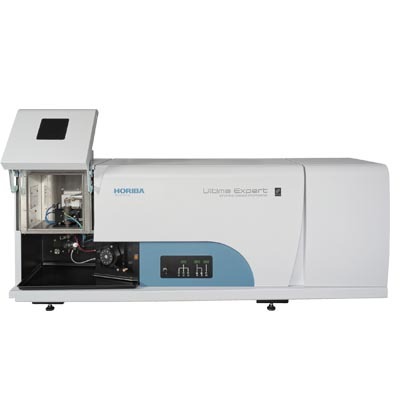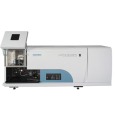方案详情
文
HORIBA Scientific ICPs have the ability to analyze very difficult samples, such as those with high salt content, in part due to the large 3 mm ID injector. In addition, the use of the sheath gas device, originally patented by HORIBA Scientific, enables analysis without clogging of the injector tube and provides the capability of running samples up to 300 g/L salt content.
The flexibility of the ULTIMA configuration enables you to choose the gratings depending on the applications, such as the dual grating (4320 and 2400 gr/mm), which provides high resolution and low LOD, in the 200 - 400 nm region. This is particularly useful for the analysis of impurities in rare earths and precious metals.
方案详情

|CP ATOMIC EMISSION SPECTROSCOPYAPPLICATION NOTE 31 Limits of Detection Obtained by ICP-OES in 10 g/L Rhodium Nathalie Le Corre Jobin Yvon S.A.S., Horiba Group Longjumeau,France 1 Introduction The analysis of impurities in Rhodium samplesrequires an instrument with high resolution toavoid inter-element correction and obtain lowdetection limits. For this reason the ULTIMAwas used. This Application Note reports thewavelengths that were used in this difficultmatrix and the detection limits obtained. 2 Principle 2.1 Technique used The elemental analysis of solutions was under-taken by Inductively Coupled Plasma AtomicEmission Spectrometry (ICP-AES). The sampleis nebulized then transferred to an argon plas-ma. It is decomposed, atomized and ionizedwhereby the atoms and ions are excited. Wemeasure the intensity of the light emitted whenthe atoms orions return to lower levels of ener-gy. Each element emits light at characteristicwavelengths and these lines can be used forquantitative analysis after a calibration. 2.2 Wavelength choice The choice of the wavelength in a given matrixcan be made using the“profile" function, or byusing Win-IMAGE, which is rapid semi-quantita-tive analysis mode using multiple wavelengths.The principle is the same in either case: recordthe scans of analytes at low concentration, andof the matrix. By superimposing the spectra, wesee possible interferences. 2.3 Limits of detection estimation The limits of detection are calculated using thefollowing formula: With: LOD = limits of detection, k= 3 for the normal 3-sigma values, BEC= Background equivalent concentration, RSDo = relative standard deviation of the blank. To calculate the LOD, a calibration curve is con-structed using two points, 0 ppm and 5 ppm, orsome concentration where the calibration is lin-ear; this gives the BEC. The RSDo is evaluatedby running the blank ten times. 3 Sample Preparation The samples were prepared in HCI giving aRhCl3/HCl matrix. 4 Instrument specification The work was done on a ULTIMA.The specifica-tions of this instrument are listed below inTables 1 and 2. Table 1: Specification of spectrometer Parameters Specifications Mounting Czerny Turner Focal length 1m Nitrogen purge Yes Variable resolution Yes Grating number of grooves 2400 gr/mm 2nd order Table 2: Specification of RF Generator Parameters Specifications Type of generator Solid state Observation Radial Frequency 40.68 MHz Control of gas flowrate by computer Control of pump flow by computer Cooling air In order to measure at high resolution (5 pm)and to measure the entire spectral range (160 -800 nm), two gratings were used. The first onecovers the 160-420 nm range with a resolutionof 5.5 pm. The second one covers the rest of thespectral range, up to 800 nm. 5 Operating conditions The operating conditions are listed in Table 3below. Table 3: Operating conditions Parameter Condition RF Generator power 1100 W Plasma gas flowrate 12 L/min Auxiliary gas flowrate 0 L/min Sheath gas flowrate 0.2 L/min 0.8 L/min for Na, K Nebulizer flowrate 3 bars Sample uptake 1 mL/min Type of nebulizer Meinhard Type of spray chamber Cyclonic Argon humidifier Yes Injector tube diameter 3.0 mm 6 Wavelength selection and analyti-cal conditions The limits of detection were determined using thefollowing parameters: Mode of calculation: Mode maximum Entrance slit: 20 um Exit slit: 15 um Integration time:4s 7 Limits of Detection Three standards were used STD1, STD2 and STD3.The concentrations are listed in Table 4 below inmg/kg. Table 4: Standard concentration The limits of detection were determined using theformula given in section 2.3 and are given in Table5. Table 5: Limits of Detection 343.823 France: HORIBA Jobin Yvon S.A.S., 16-18 rue du Canal,91165 Longjumeau Cedex- Tel: +33 (0)1 64 54 13 00- Fax: +33 (0)1 69 09 07 21-Email: info-sci.fr@horiba.com USA: HORIBA Jobin Yvon Inc., 3880 Park Avenue, Edison, NJ 08820-3012.Toll-free: +1-866-jobinyvon -Tel: +1-732-494-8660- Fax: +1-732-549-5125Email: info-sci.us@horiba.comJapan: HORIBA Ltd., Scientific Instruments Sales Dept., Alte-Building Higashi-Kanda, 1-7-8 Higashi-Kanda, Chiyoda-ku, 101-0031 Tokyo - Tel: +81 (0)3 3861 8231Fax: +81 (0)3 3861 8259-Email: info-sci.jp@horiba.comGermany: HORIBA Jobin Yvon GmbH, Hauptstrasse 1, 82008 Unterhaching -Tel:+49 (0)89 46 23 17-0- Fax: +49 (0)89 46 23 17-99-Email: info-sci.de@horiba.comItaly: HORIBA Jobin Yvon Srl, Via Cesare Pavese 35/AB, 20090 Opera (Milano)- Tel: +39 0 2 57 60 30 50-Fax: +39 0 2 57 60 08 76-Email: info-sci.it@horiba.comUK: HORIBA Jobin Yvon Ltd, 2 Dalston Gardens, Stanmore, Middlesex HA7 1BQ- Tel: +44 (0)20 8204 814-Fax:+44 (0)20 82046142-Email: info-sci.uk@horiba.com China: HORIBA Jobin Yvon SAS, Room 1801, Capital Tower No.6, Jianguomenwai Av., Chaoyang District, Beijing 100022 -Tel: +86 (0)10 8567 9966-Fax: +86 (0)10 8567 9066 Email: info-sci.cn@horiba.com Other Countries: Tel:+33 (0)1 64 54 13 00 - Email: info.sci@horiba.com HORIBA ORIBAScientific HORIBA Scientific ICPs have the ability to analyze very difficult samples, such as those with high salt content, in part due to the large 3 mm ID injector. In addition, the use of the sheath gas device, originally patented by HORIBA Scientific, enables analysis without clogging of the injector tube and provides the capability of running samples up to 300 g/L salt content. The flexibility of the ULTIMA configuration enables you to choose the gratings depending on the applications, such as the dual grating (4320 and 2400 gr/mm), which provides high resolution and low LOD, in the 200 - 400 nm region. This is particularly useful for the analysis of impurities in rare earths and precious metals.
确定



还剩1页未读,是否继续阅读?
HORIBA(中国)为您提供《10g/L铑溶液中元素检测方案(ICP-AES)》,该方案主要用于其他中元素检测,参考标准--,《10g/L铑溶液中元素检测方案(ICP-AES)》用到的仪器有HORIBA Ultima Expert高性能ICP光谱仪
相关方案
更多
该厂商其他方案
更多










